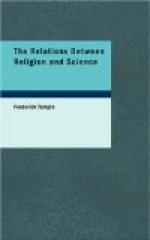It is clear that this wonderfully ingenious speculation rests its claims for acceptance purely on the assertion that it and it alone explains the facts. It cannot be proved from any principle of reason. It assumes that there is a demonstrative science of Mathematics quite independent of experience, and that there are necessary principles of Physics equally independent of experience. And it accounts for the existence of these.
With Mathematics we are not now concerned, and I will pass them by with only one remark. The ground on which Kant’s theory stands is not sufficient, for this simple reason. It accounts for one fact; it does not account for another fact. It accounts for the fact that we attach and cannot help attaching a conviction of necessity to all mathematical reasoning. We not only know that two straight lines cannot enclose a space, but we know that this is so and must be so in all places and at all times, and we know it without any proof whatever. This fact Kant accounts for. Space is according to him a part of our kaleidoscope; you can always look into it and see for yourself what are the laws of it. But there is another fact. This space of which we are speaking is unquestionably to our minds not a thing inside of us but outside of us. We are in it. We cannot get rid of a sense that it is independent of ourselves. We can imagine ourselves non-existing, minds and all. We cannot imagine space non-existing. If it be a part of our minds, how is it that we can picture to ourselves the non-existence of the mind which is the whole, but not the non-existence of space which, according to the hypothesis, is the part? For this fact, which we commonly call the objectivity of space, Kant’s theory does not account. In fact Kant appears to have no escape from assigning this objectivity of space to delusion. But a theory which requires us to call an ineradicable conviction of consciousness a delusion cannot be said to explain all the facts. John Stuart Mill maintains that the other fact, namely, the conviction of the necessity of mathematical truth, is a delusion. And his account also must be pronounced for that reason to fail in accounting for all the facts.




